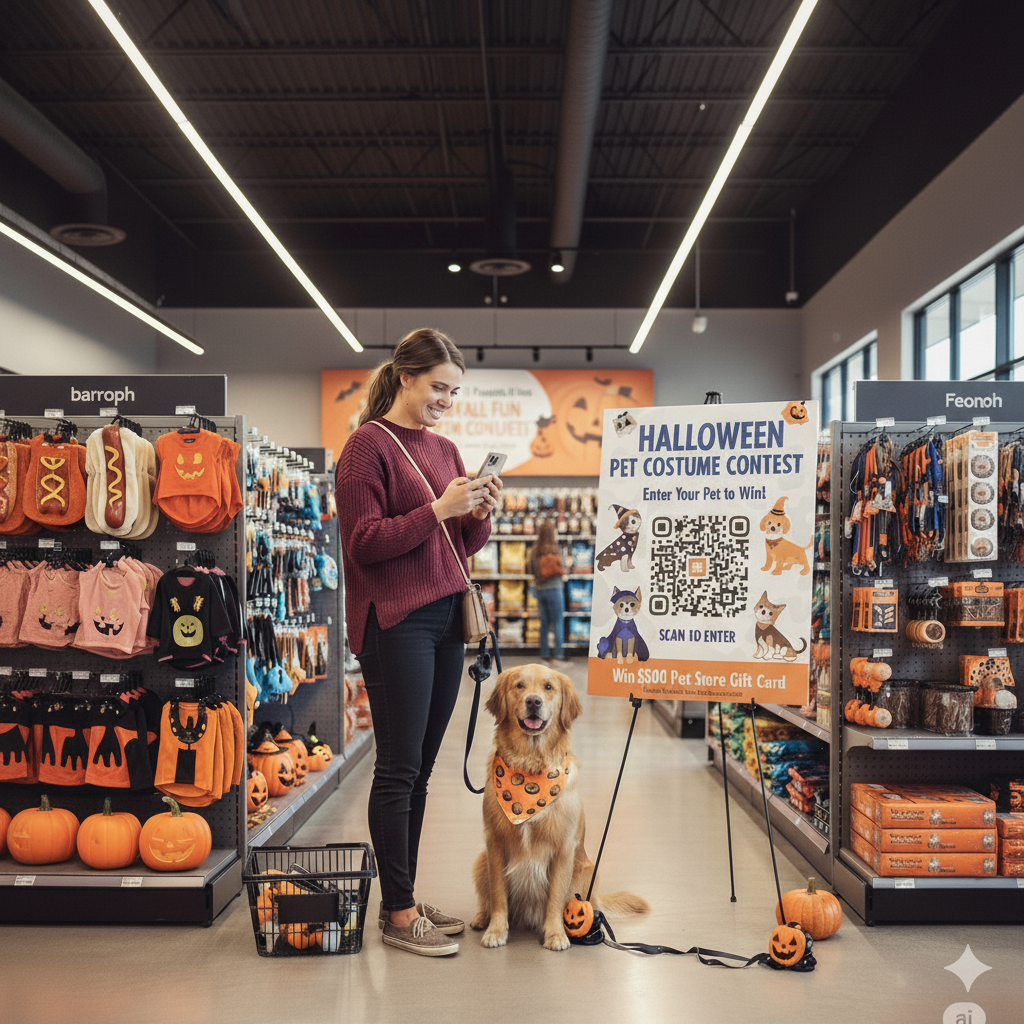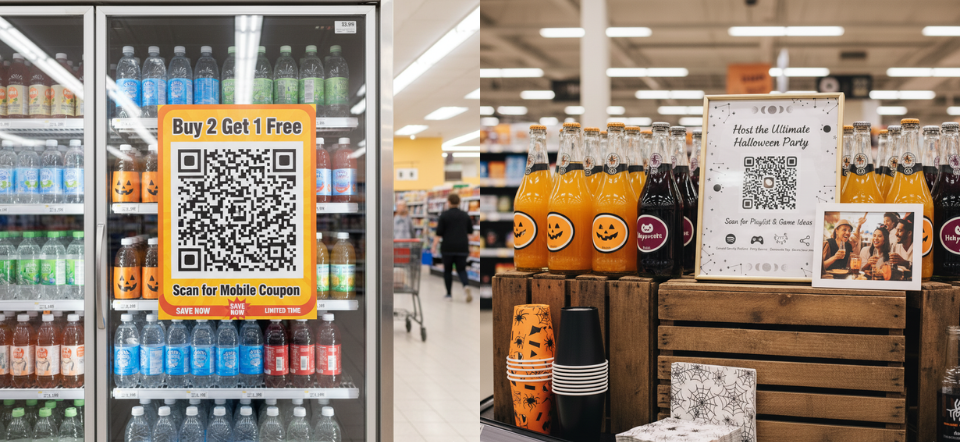Halloween Retail Starts in September. Your Campaign Doesn't.

Walk into any Target or Home Depot in September and you’ll see it: aisles of pumpkin lights and Halloween decorations competing for space with back-to-school supplies. For years, retailers have been mocked for “holiday creep.” Turns out, they were onto something.
According to the National Retail Federation, 47% of U.S. consumers now start their Halloween shopping before October. Five years ago, that number was closer to one in three.
The disconnect? Most marketing campaigns still launch too late to catch that first wave of curiosity.
Being early isn’t just about timing; it’s about relevance. Retailers need a way to engage shoppers in September without requiring a full campaign buildout. QR Codes are becoming that bridge. These codes help retailers meet customers earlier in their journey and turn September planning into a new retail advantage.
But that advantage only works if campaigns actually start in September. Most don't, and that's exposing the cracks in how Halloween marketing has always been done.
Why traditional Halloween marketing is losing its magic
For years, Halloween retail followed a simple playbook: pile up themed inventory, drop prices in mid-October, and wait for the last-minute shopping rush. It worked when shoppers made impulse decisions. But that’s changed now.
Today, shoppers approach Halloween differently. They start early, browse ideas across platforms, and look for inspiration as much as offers.
Nearly half of all Halloween-based QR Codes go live in September, confirming how far in advance the engagement begins. Source: Uniqode retail QR Code analysis (2022-2025) | 1,951 brands | U.S., Canada, U.K., Australia
This aligns with rising retail QR adoption trends that show how early seasonal engagement is becoming the new normal.
This shift has left traditional campaigns struggling for relevance. With every retailer running a “spooky sale,” the offers start to blur together—all pushing products, none offering inspiration.
However, today's shoppers want ideas first, purchases second, and they want them early.
The brands that win in this environment are the ones giving people reasons to engage, not just reasons to spend. That’s where QR Codes step in, not as another sales tool, but as a way to rebuild relevance, turning early interest into measurable engagement.
How QR Codes bring Halloween campaigns to life
A grocery brand used QR Codes on candy displays to share quick Halloween recipes and decoration ideas. A local retailer added them to event flyers for trunk-or-treat signups. What once were static, transactional moments like “buy this” or “visit that” turned into small, interactive invitations to be a part of the Halloween season.
This shift shows up clearly in the data. The brands that leaned into customer interaction saw steadier engagement across their Halloween campaigns, especially those that launched early. QR Codes became the missing link between curiosity and participation, helping marketers stay visible throughout the shopping journey, not just at checkout.
What makes QR Codes particularly powerful for Halloween is how easily they adapt. If a trunk-or-treat fills up faster than expected, update the scan page to close registrations. If a recipe code is getting heavy traffic, swap in a related product offer before the weekend. That flexibility to react in real time is what separates a campaign that simply runs from one that truly connects.
But showing up early with an adaptable tool is only part of the equation. What makes some campaigns outperform others?
What successful Halloween campaigns have in common
Look closely at the Halloween campaigns that stand out in recent years, and a clear pattern emerges.
The winning ideas aren’t the loudest or boldest but the most intentional. These brands treat QR Codes as a creative bridge between discovery and action, and it shows.
1. They start earlier than everyone else
Timing is a strategy, not an afterthought. Brands that launch teasers, sneak peeks, or RSVP-led activations before October shape customer expectations instead of chasing them. Early activity keeps them visible while others are still preparing to go live.
2. They build community around participation
Halloween has always been a social moment, and retailers that tap into that spirit win attention that ads can’t buy. QR Codes become the entry point for community-led events, contests, and local experiences, from family gatherings to charity drives. Community activations generate sustained interest that standard promotional campaigns often struggle to match.
3. They lead with emotion, not promotion
Pet, grocery, and lifestyle brands succeed when they tap into emotions like joy, nostalgia, and creativity. The pet category alone shows how powerful that connection can be. The global pet costume market was valued at $1.72 billion in 2023 and is projected to grow 6.1% annually through 2028, with Halloween driving about 65% of total costume sales.

That level of enthusiasm shows how emotional connection can outperform standard discounting. Whether it’s a costume contest, a family recipe, or a DIY tutorial, the best campaigns don’t sell products; they invite people into moments.
4. They design for exploration, not instruction
Winning campaigns give shoppers multiple ways to engage. Instead of a single “Buy Now” link, they offer choices: view the recipe, enter the contest, find nearby stores, or share on social media. When people explore on their own terms, the experience feels guided, not forced, making engagement feel like discovery rather than a sales pitch.
5. They turn everyday products into seasonal content
High-performing Halloween campaigns make ordinary products do more. Grocery and beverage retailers turned packaging into content hubs, using QR Codes to share Halloween recipes and DIY ideas. It shows how even everyday products become touchpoints for engagement when the content feels timely and relevant.

Together, these campaigns show how small creative choices in timing, tone, and context can turn a seasonal promotion into an ongoing conversation.
The Halloween shift: From campaigns to connections
If Halloween retail starts in September, then so should your strategy. The brands turning curiosity into engagement set the pace instead of waiting for the crowd. This season has made one thing clear: timing is no longer a calendar decision, but a competitive one.
QR Codes are the fastest way to meet customers where they already are: curious, scrolling, and ready to take part. And what gets them to scan? Not discounts alone, but invitations to enter a contest, try a recipe, or join an event. Halloween proves engagement doesn't just require discounts—it requires giving people something worth participating in. And if you want to keep seasonal momentum going beyond Halloween, use the same QR-driven engagement loops to nurture shoppers well into the next retail cycle.
Next up: Black Friday and Cyber Monday. Get the complete QR Code marketing guide for retail's biggest weekend.
